You know you need SEO. It’s probably been in the back of your mind for some time now.
Maybe you’ve worked with expensive agencies in the past. They’ve probably sent over complex charts that seem to go up and to the right, but if you were honest, you don’t really know what you’re looking at.
For many, SEO is a mysterious black box. Nobody understands what it is, much less how it works. This leaves room for bad actors to come in and charge a pretty penny without actually giving you the results you’re after — more leads, traffic, and sales.
In this post (and corresponding YouTube series), I’ll go over everything you need to know about SEO.
Whether you’re a busy marketing director, entrepreneur, or small business owner, you’ll have everything you need to communicate effectively with your agency or freelance SEO, or even do it all yourself.
We’ve got a lot of ground to cover so let’s jump in.
Google Makes Money When It’s the Best Search Engine
Many believe Google is like an angry deity that only tolerates ranking content. But Google Ads make up the lion’s share of Google’s revenue, so it’s in their best interest to keep people hooked into their search engine, as opposed to Bing or any other way people find content online.
(My cool Gen Z friends are telling me they all use Instagram and TikTok as their main search engine now.)
How does Google do that? By surfacing the best content for the users’ query. Granted, Google is a business and will always put its interests first, but Google actually wants high-quality content creators to rank. Because when great content ranks, people stick around, and Google makes money.
Makes sense?
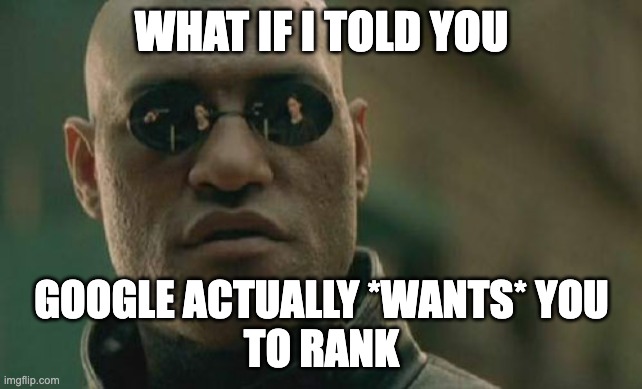
And the thing most people don’t realize is that Google gives us an instruction manual for ranking on Google Search Central.
But let’s not get ahead of ourselves. First, we need to lay some groundwork about how Google works.
How Google Works
Google’s stated goal is to “organize the world’s information and make it universally accessible and useful.”
Practically, it does this in three steps:
- Crawling
- Indexing
- Serving search results
Let’s break these down.
Step 1: Crawling the Web
Do you remember the beginning of The Empire Strikes Back when Vader sends probe droids across the galaxy to locate the Rebel base?
That’s essentially what Google does, except on a much bigger scale. Googlebot is a software program Google sends out to scan the entire internet. Yes, the entire internet.

These bots or “spiders” are automated and work tirelessly. They visit websites of all sizes, from well-known giants like Forbes to obscure blogs (like this one), to collect information that might be useful to users.
These crawlers look at webpages and follow links on these pages, much like you would if you were browsing content on the web.
When crawlers find a webpage, they decode the page’s content and note the key information, such as keywords and website freshness, which all affect how it’s indexed.
Crawlers also (usually) respect instructions provided by websites on what they should and should not crawl through mechanisms like the “robots.txt” file. This allows website owners to control the crawl traffic and ensure that Googlebot doesn’t access sensitive or irrelevant parts of a site.
Now that we understand how Google crawls the web, let’s look at the next step: Indexing.
Step 2: Indexing the Web
Once the Google bots have crawled the web pages, the next step is indexing. Indexing involves analyzing the contents of each page and organizing the information into a vast database — Google’s index.
Think of it as creating a huge, incredibly detailed, sophisticated catalog of every book in a library, but for the web. This index must be highly organized to allow Google’s algorithms to pull up relevant information instantly when users perform a search.

During indexing, Googlebot processes and compiles a massive list of all the words it sees and their location on each page. It also gathers key attributes from the content of the webpage, such as title tags, ALT attributes, and more.
Additionally, Google understands and catalogs information about images and videos embedded on web pages, which also factors into search results.
Google’s algorithms will also analyze the content to understand the topic of a page, which is crucial for determining the page’s relevance to particular search queries.
Google uses highly advanced natural language processing (NLP) technology, allowing the indexing system to discern topics, contexts, and even the intent behind the words on the page.
Another part of the indexing process is the assessment of the quality and quantity of other web pages that link to the page being indexed. These links are like votes or referrals for a webpage.
The more high-quality referrals (links) a page has, the more authority Google grants it, which is a key factor in its ranking algorithm. We’ll talk much more about this later in this post as well as in other upcoming posts on off-page SEO.
The index is constantly being updated and revised. As new pages are crawled and existing pages are updated or removed, the index changes.
This helps Google to deliver the most current information to users. If a webpage is not indexed, it cannot be displayed in search results, which is why webmasters need to ensure their pages are crawlable and indexable.
After indexing comes the final and most visible part of the process: serving search results to users.
Step 3: Serving Search Results
The final step in Google’s process is serving relevant results to each searcher. When you enter a query (also known as a keyword) into Google, the search engine does its best to retrieve the most relevant information to the organic search results page.
Note: any query typed into the Google search bar is a keyword, regardless of how many individual words it contains. “cars” is a keyword. So is “vintage car shows near me.”
The search results are ideally ranked by relevance (but Google certainly isn’t perfect). This involves algorithms considering hundreds of factors, known as ranking signals, to determine the order in which results appear.
Google doesn’t publicize exactly how they rank websites (otherwise SEOs would all be gaming the system more than they already do), but they do give us some helpful pointers, which I take about in my video on the content that Google loves to rank.
These signals include factors like:
- Keyword presence and density
- Site speed
- Mobile-friendliness
- Backlinks
- Domain authority
And many others.
Personalization also plays a role in how search results are served. Depending on whether you’re logged into your Google account and your past search behavior, the results can be tailored to better suit your interests and likely intentions.
Each keyword has a corresponding Search Engine Results Page (SERP). These can often feature a variety of information types, including
- Webpages
- News articles
- Images
- Videos
- Local business listings
And more, all blended together to provide a comprehensive response to your search query. For example, look at all the features on this SERP for the keyword “travis kelce.”
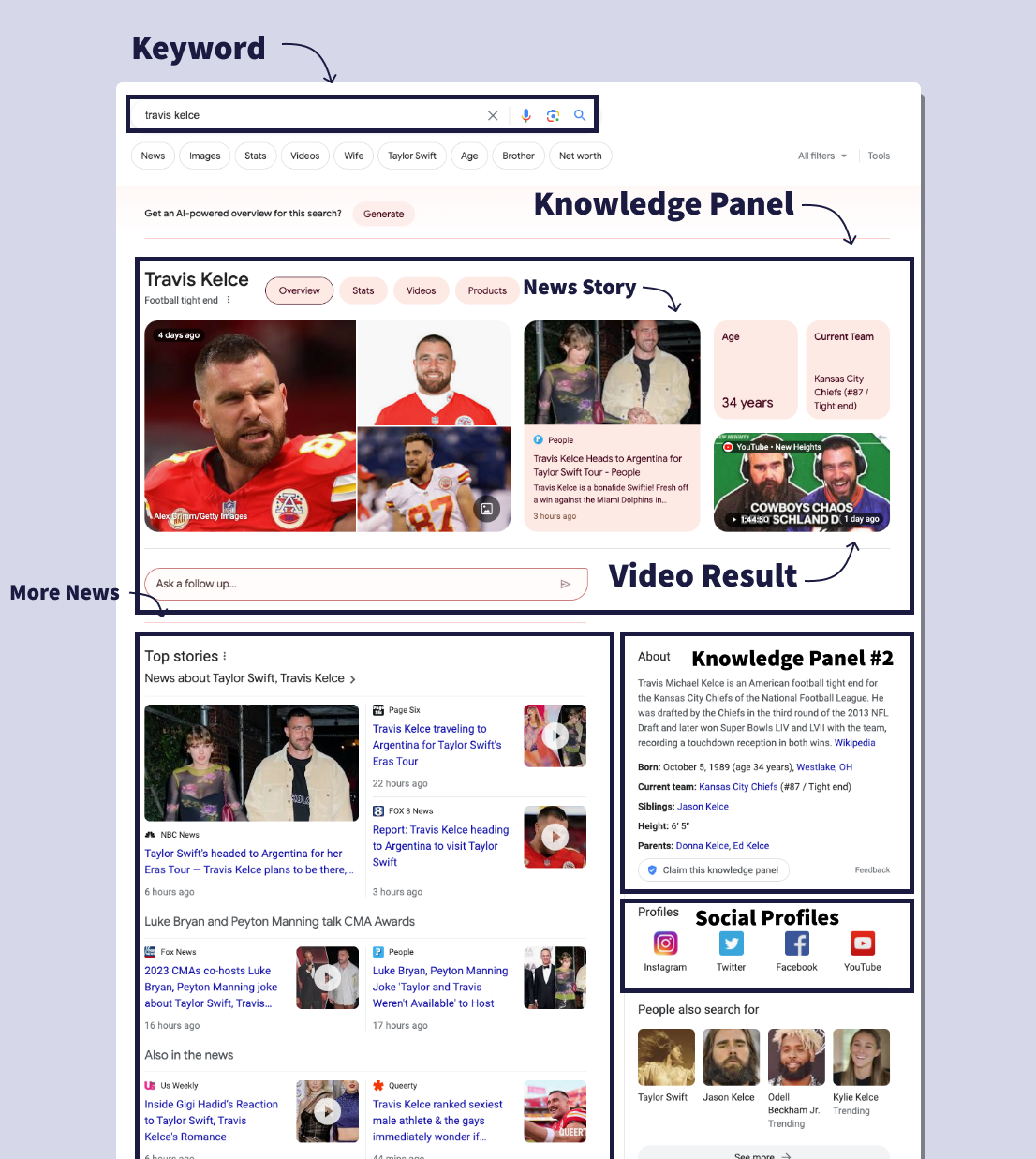
Additionally, Google provides features like snippets, knowledge panels, and predictive search to enhance the user experience.
Snippets provide highlighted excerpts from web pages that directly answer questions.
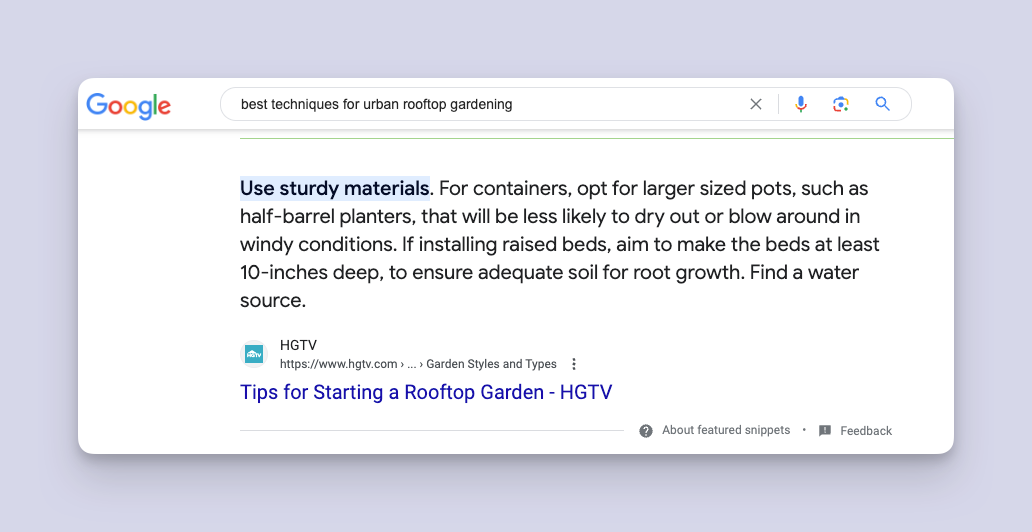
Knowledge panels (as illustrated in the travis kelce SERP graphic above) gather a wide array of information from various sources about common queries like famous people, places, or things.
Predictive search offers search suggestions as you type, based on common queries and your search history.
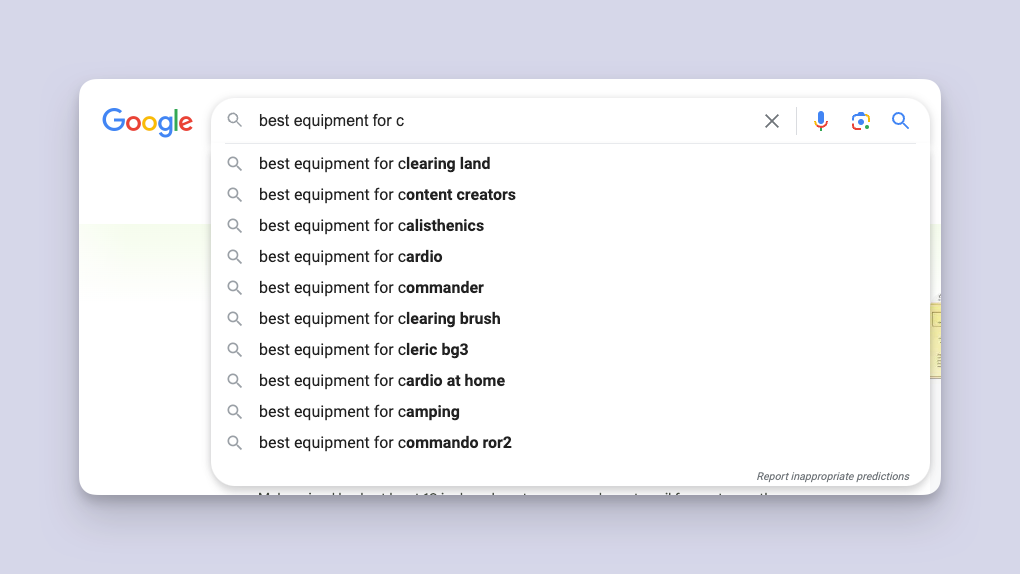
And, of course, I’d be remiss not to mention Google’s new experiment, the AI-powered Search Generative Experience (SGE), which has gotten quite a few SEOs in a tizzy.
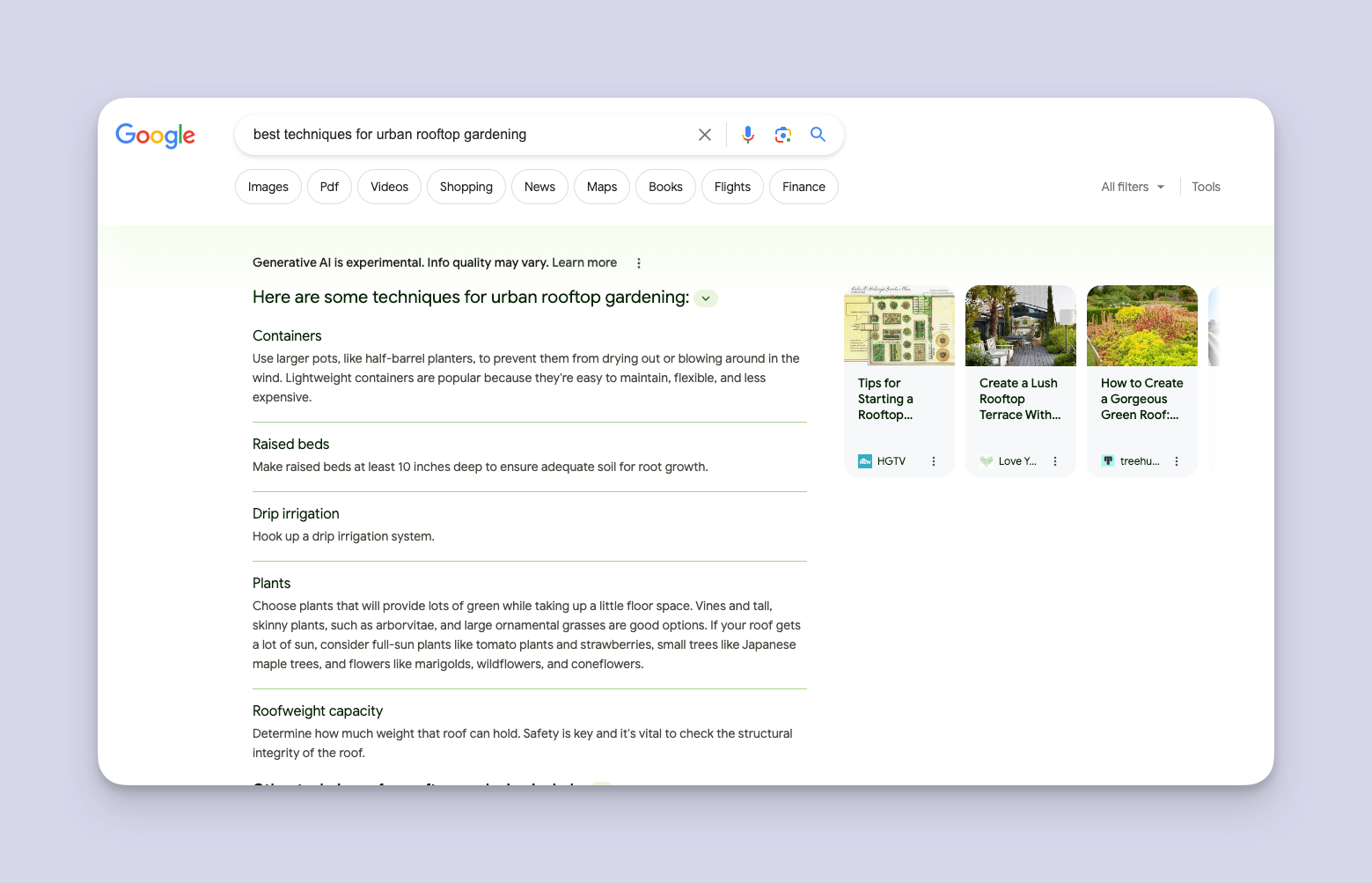
Now that you have a thorough understanding of how Google works and the power of user intent, let’s talk about how you can optimize for that sweet, sweet organic search traffic!
Understanding SEO (Search Engine Optimization)
Google defines SEO as “the process of making your site better for search engines.”
I like to go a bit more in-depth. My definition of SEO is:
Giving the searcher exactly what they’re looking for in the exact format Google wants you to give it.
If there’s one concept you take away from this post, let it be the importance of user intent.
Even as someone who’s been doing SEO for 10 years, I have to bring myself back to this fundamental concept.
Search engines work by matching search engine results pages (SERPs) with the proper user intent, and Google’s gotten really good at it over the years.
User intent can be broadly classified into the following categories:
Informational intent
These searchers are just fact-finding or researching. They’re likely not looking to buy anything. Informational queries will almost always include the terms “what,” “who,” “why,” “when,” “where,” and sometimes “how.”
For example:
- “How to choose a chainsaw”
- “What is monkeypox”
- “Why is the sky blue”
- “How long does it take to get a passport”
Educational intent
Educational intent is when searchers are looking for exact step-by-step instructions on how to accomplish something or achieve an outcome. Educational intent keywords almost always include the word “how.”
Video is often the ideal format to help educational intent searchers solve their problems, so Google will frequently serve up video results for these types of searches.
Examples include:
- “How to solve a Rubik’s cube”
- “How long to boil eggs”
- “How to write a cover letter”
- “How to screenshot on Windows”
At times, users are trying to navigate to a particular website or page they already have in mind. In these cases, the goal is to serve content that connects users to their desired destination. These are also called “branded queries.”
For example:
- “facebook”
- “youtube”
- “sephora”
- “amazon”
Commercial intent
Commercial intent keywords convey buying intent. These searchers are likely either ready to buy or comparing products to purchase. Commercial intent keywords are your “money” keywords, but they’re also often the most competitive and hardest to rank for.
These keywords often include words like “best,” “vs,” (for comparing products), brand names (“Nike”), and of course, “buy.”
Here are some examples:
- “clickup vs monday.com”
- “best skincare products for acne-prone skin”
- “last-minute flight deals to NYC”
- “trademark registration lawyers near me”
- “buy organic dog food”
One of the signs of a thriving website is that it will often rank for keywords in all of these categories (except for content publishing websites that don’t sell anything).
When it comes to B2B SaaS, for example, you’ll want to have a healthy mixture of pages that target all of these user intent scenarios.
For example, consider Gusto, a fantastic HR and payroll SaaS platform (I’ve used it myself and it’s a great experience).

If I run their site through Ahrefs Site Explorer, I see the following pages in the top 10 Google search results:
- Their homepage ranks for “gusto” (navigational intent)
- This page ranks for “what’s the difference between net pay and gross pay?” (informational intent)
- This page ranks for “paycheck calculator” (educational intent)
- This page ranks for “gusto pricing” (commercial intent)
We’ll talk more about which keywords to target in a future post on keyword research.
Pros & Cons of SEO vs Other Marketing Channels
SEO is a crucial component of digital marketing, but it’s important to weigh its advantages and disadvantages against other marketing channels.
| Marketing Channel | Pros | Cons |
|---|---|---|
| SEO | Cost-effective in the long run, targets quality traffic, improves site usability, builds trust and credibility. | Takes time to see results, requires ongoing effort, complex algorithms to navigate. |
| Pay-Per-Click (PPC) | Quick results, easy to measure and track, control over budget and scheduling. | Can be expensive, dependent on continuous investment, potential for click fraud. |
| Social Media Marketing | Enhances engagement, builds community, targets specific demographics. | Requires constant content creation, may involve paid advertising for more significant reach. |
| Email Marketing | Direct communication with customers, high ROI, easy to personalize. | Can be seen as spam, competition with other emails, need to build a subscriber list. |
| Influencer Marketing | Builds trust through association, high engagement rates, taps into influencer audiences. | Can be expensive, risks if the influencer gets negative publicity, less control over the message. |
While SEO provides a foundation for organic growth, it should be part of a broader strategy that includes various channels depending on the specific goals and target audience.
The Three Pillars of SEO: On-Page, Off-Page, and Technical SEO
The three core disciplines or areas of SEO success are:
- On-page SEO
- Off-page SEO
- Technical SEO
If you master these three, you put yourself in the best possible position for higher rankings. We’ll talk about each of these in more detail in future posts, but here’s an overview.
On-page SEO
On-page SEO is, as you may have guessed, all of the factors on the page itself that contribute to your SEO.
These include, but aren’t limited to:
- E-E-A-T: This stands for Experience, Expertise, Authoritativeness, and Trustworthiness, which are factors that Google uses to determine the quality of a webpage.
- Title Tag: The title of the page that appears in search engine results and browser tabs.
- Meta Description: A brief description of the page content that appears under the title in search engine results.
- URL: The web address of the page, which should be concise and include relevant keywords.
- Heading Tags (H1, H2, H3, etc.): HTML tags used to denote headings and subheadings on a page, which help structure the content for readers and search engines.
- Alt Tags (for images): Text descriptions of images, which help search engines discover and understand the image content.
- Keywords: Relevant words or phrases that users might search for and which should be incorporated into the page content.
- SEO Content: Content that is written to rank well in search engines and cater to the needs and intent of users searching for related information.
- Internal Links: Links that go from one page on a domain to a different page on the same domain, which help establish site architecture and spread link equity.
- Page Speed: The loading time of a page, which is a factor in Google’s ranking algorithm.
- Mobile-friendliness: A design that ensures the webpage is usable and readable on mobile devices.
- User Engagement: Metrics that reflect how users interact with a page, such as time on page and bounce rate, indicating the page’s relevance and usefulness to visitors.
We’ll talk all about on-page SEO in an upcoming post. As a copywriter and content marketer at heart, it’s one of my favorite aspects of SEO.
Off-page SEO
Off-page SEO refers to anything that happens outside of your site or page. This can mean a few things, but primarily, it means backlinks.
Here’s why backlinks are important. Let’s say you start a new website all about how to make sourdough bread. You spin up a bunch of content perfectly in line with Google’s best practices. The only problem: everything you’re writing is completely incorrect.
You write that sourdough is so fast and can be enjoyed the same day you make it (it can’t). You say you don’t need to wait for your starter to rise and you can even make it right in the microwave.
What would happen if Google only paid attention to on-page signals? They would likely rank this site, and thus mislead hundreds or thousands of monthly searchers.
Google relies heavily on backlinks (links from other websites back to yours) when figuring out how highly to rank a website for a search term.
External links are essentially votes of confidence in Google’s eyes. They’re like the rest of the internet saying, “Hey, this guy is legit. So legit, that we’re willing to send our users to his site.”
The higher the authority of the site, the higher the value of the backlink. If you get a backlink from your aunt’s little recipe blog, that probably won’t do much.
If you get a backlink from a hyper-relevant blog in your niche, that’s worth a good amount of authority. If you get a backlink from Forbes or Inc., that’s worth a substantial amount of authority.
SEOs like to measure a domain’s authority by a metric called DA (domain authority) or DR (domain rating). These are not official Google metrics, but rather values assigned by notable SEO tools like Ahrefs and SEMrush.
For example, my niche site Composer Code has a DA of 17 (out of 100, according to Ahrefs), while Zendesk has a DA of 93.
Some SEOs devote their entire careers to building backlinks; it’s that important. We’ll talk about it more in a future post.
Technical SEO
When Google looks at your page, they don’t see what a user sees – they see lines of code.
This code can either “play nice” with Google’s rules, or make things harder for Google (and thus, your users).
Slow, clunky, inefficient sites full of broken links and 404s are a pain for users, and Google recognizes this. That’s why they prioritize technically healthy sites.
Technical SEO is the practice of making the code of your pages (and overall site) fast, secure, mobile-friendly, and following Google’s best practices.
Here are some of the crucial elements of technical SEO:
- Crawling and Indexing: Ensuring that search engines can efficiently crawl and index the website’s content.
- Rendering: Making sure that search engines can render the website like a browser would.
- Website Architecture: Structuring a website in a way that helps search engines understand and rank the content.
- JavaScript: Managing and optimizing JavaScript for better crawling and indexing.
- XML Sitemaps: Creating and managing XML sitemaps to assist search engines in finding and indexing pages.
- URL Structure: Designing URL structures that are friendly to both users and search engines.
- Structured Data: Implementing structured data to help search engines understand the context of the content.
- Thin Content: Addressing and improving pages with insufficient content.
- Duplicate Content: Identifying and resolving issues with identical or very similar content across multiple URLs.
- Hreflang: Using hreflang tags for language and regional URLs to tell search engines about localized versions of a page.
- Canonical Tags: Employing canonical tags to signal the preferred URL of similar or duplicate content to search engines.
- 404 Pages: Handling 404 errors effectively to improve user experience and maintain search engine trust.
- 301 Redirects: Properly using 301 redirects to manage the redirection of traffic from old to new URLs.
We’ll get more into this in a future post all about technical SEO.
Essential Tools for Search Engine Marketing
If you’re serious about developing a winning SEO strategy and dominating the search rankings, you’ll need to utilize some SEO tools.
While you can do great SEO using nothing but Google itself, you’re going to save a lot of time and grief by investing in platforms that streamline or completely automate many essential SEO processes.
The Basics
The cornerstone of any search engine marketing toolkit begins with these two classics: Google Analytics and Google Search Console. These tools are fundamental for understanding and improving your website’s relationship with Google.
Google Analytics is a powerhouse for tracking user interaction, providing detailed reports on website traffic, user engagement, and conversion metrics.
This tool allows marketers to make data-driven decisions, ensuring that they understand their audience’s behavior and can tailor their SEO strategies accordingly.
Google Search Console, on the other hand, focuses on the site’s visibility on Google. It offers insights into the search queries that bring users to your site, the effectiveness of your rich snippets, and how well your mobile site performs.
It also alerts you to any issues that Google has with indexing or crawling your site, which is essential for maintaining your search presence.
Rank Tracking Tools
Let’s say you’re targeting the keyword “best organic food for cats.” Maybe you look at Google Search Console and realize you’re ranking in position 12 for that term.
You make a bunch of page optimizations and then move on to the next keyword/page. A few months later, you remember, “Oh yeah, I wonder how that page is doing.”
It turns out you’re now ranking in position 50 for that keyword – whatever you did on the page pushed it down the rankings instead of up!
Now multiply that by dozens or hundreds of keywords/pages, and you can see why having a rank tracker is so important.
Rank tracking tools will show you exactly where you’re ranking in the SERP, for what page the keyword ranks, and any notable changes over time.
Many tools will also show you the estimated traffic you’re getting from the keyword/page, though the most definitive way to find this is through Google Search Console and Google Analytics.
If you don’t have a rank tracker, it is possible to track your desired keywords in Google Search Console. It just takes a bit more time and effort.
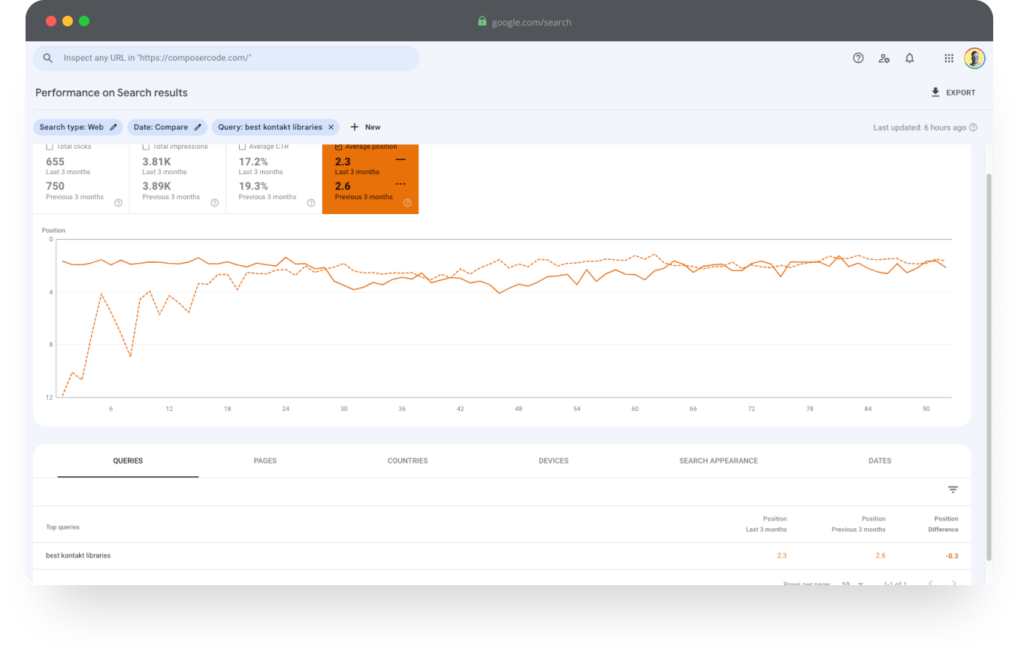
Here’s how to do it:
- Login to Google Search Console and select your desired property
- Click on Search results under the Performance menu
- Make sure the Average position box is checked in the time series graph
- Click + New on the top filters menu
- Add a filter of Query…
- Click the Queries containing dropdown and switch it to Exact query
- Paste your keyword in and click Apply
- Click the Date: Last 6 months and click Compare. Select whichever timeframe you’d like to compare and click Apply
- You can now see the Position Difference in the data chart and the time series graph, as well as the difference in Clicks, Impressions, etc.
Typing in individual keywords one by one to track rankings isn’t sustainable.
However, there is a way to use RegEx and Google Looker Studio to build your own bulk rank tracker, but that goes well beyond the scope of this introductory article (as much as I would love to nerd out on that, I’ll have to save it for later). 😎
Keyword Research Tools
Keyword research is all about understanding which terms your users are searching for and how to prioritize them in your SEO efforts.
Doing poor keyword research is like building a house on a cracked foundation. You may get a few walls up, but eventually, the whole structure will come crumbling down.
It’s important to note that no keyword research tool is 100% correct. You should always supplement your keyword research with quantitative and qualitative knowledge, information about your customer, and good ol’ common sense.
We’ll talk more about keyword research in a full blog post soon (I know I keep saying that… SEO is a big topic.) 😅
Competitive Analysis Tools
Competitive analysis is about reverse-engineering your competitors’ websites and studying why they’re beating you in the SERPs.
These tools will often allow you to see all the keywords a site ranks for (essential for keyword research) and all the backlinks that point to your competitors’ sites.
Many competitive analysis tools will also provide estimated traffic numbers and ranking positions. Here’s an example of a site overview from Ahrefs for the website The Spruce Eats:
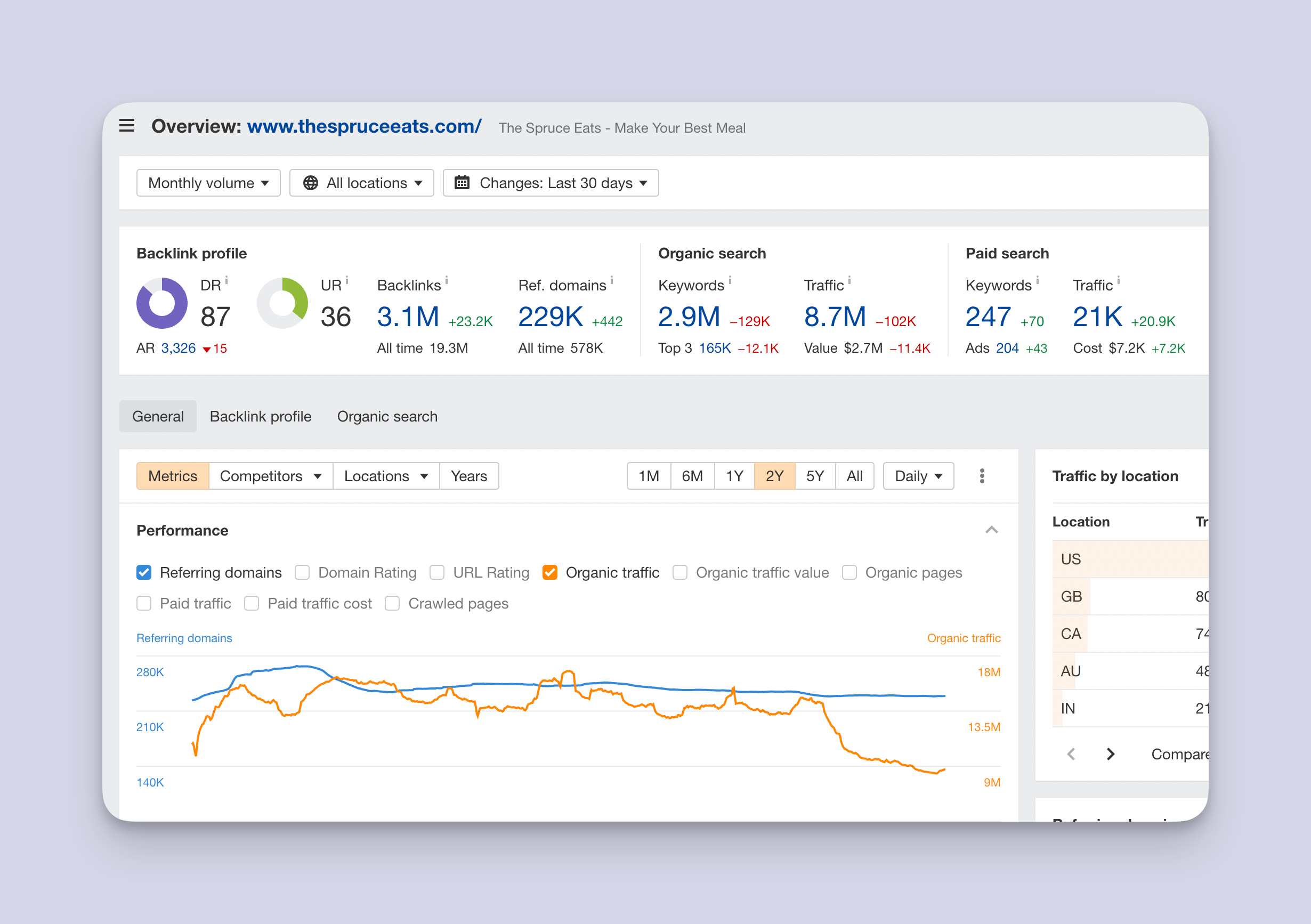
Site Scanning & Auditing Tools
Site scanning and auditing tools are the diagnostic experts of SEO. They meticulously crawl through your website, similar to how a search engine does, to find technical issues that could be harming your site’s performance in search results.
Neglecting site audits can be akin to ignoring termites in your home’s structure; it might stand now, but problems could lead to bigger issues down the line.
These tools examine everything from site speed and mobile responsiveness to meta tags and redirect chains. By identifying and fixing these issues, you ensure that the foundation of your SEO house is solid and secure.
I love Screaming Frog SEO Spider (free up to a point) for technical scans, but you have to know what you’re looking for. For quick and easy scans, I like Ahrefs Site Audit.
Backlink Analysis Tools
Backlink analysis tools help you see the quality and quantity of external sites linking back to your pages (and competitors’ pages).
These tools provide insights into these links, allowing you to strategize effectively, identify beneficial partnerships, and disavow links that might harm your site’s search engine rankings.
Notable SEO tools
Here’s a line-up of some of the best SEO tools on the market. I’ll do a deep dive on each of these in a later post.
- Google itself (free)
- Keywords Everywhere (free & paid plan)
- Ahrefs Keywords Explorer (plans start at $99/month)
- SEMRush (plans start at $129.95/month)
- SERanking (plans start at $44/month)
- KeySearch (plans start at $17/month)
- Moz Keyword Explorer (free, then paid)
- Ubersuggest (free, then paid)
- KWFinder (plans start at $29/month)
- Long Tail Pro (plans start at $59.99/month)
- SpyFu (plans start at $39/month)
Ahrefs is a standout option (and my personal favorite) for its comprehensive keyword data and additional SEO functionalities, making it an all-in-one tool for many marketers.
FAQs about Search Engine Optimization (SEO)
Although we’ve covered a lot in this post, you may still have some lingering questions. Here are some of the most commonly asked questions in SEO.
Does SEO work the same for other search engines?
SEO principles are generally consistent across different search engines, but there are nuances. For instance, Bing places more emphasis on social signals than Google.
Search engine algorithms vary from platform to platform, so strategies might need slight adjustments for optimization across different engines.
What’s the difference between SEO and paid search?
SEO focuses on optimizing websites to rank higher in organic search results, while paid search is about paying for advertisements to appear above or beside organic search results.
Does Google reveal any of its SEO ranking factors?
Google does not reveal the exact details of its algorithm, but it provides guidelines and best practices. It has confirmed some factors, like site speed, mobile-friendliness, and content quality, which affect rankings.
What’s the relationship between content marketing and SEO?
Content marketing and SEO are deeply interconnected. High-quality, valuable content is favored by search engines and can earn higher rankings, while SEO techniques can ensure that the content reaches its intended audience effectively.
Final Thoughts
SEO is one of the most rewarding and profitable marketing channels because customers are coming to you. You’re not interrupting them with ads or bombarding them with cold calls.
Organic traffic is the most highly-qualified and profitable traffic, in my experience. I hope this post has helped you lay a foundation of knowledge of SEO. As we continue through this blog series, we’ll dive deeper into each of the topics we’ve touched on here.
You may not be an SEO expert, but I hope this article has given you enough knowledge to speak intelligently to freelancers and agencies and empower you to take on SEO fixes yourself.
Thanks for reading, and I hope to see you in future posts! If you’re interested in working with me on a 1:1 basis, I take on a very select number of freelancing clients for my SEO and content marketing business.
If you think you may be a good fit, reach out to me at matt@kenyondigital.net.

